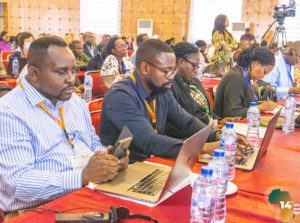The team at the UFS-NGS Unit comprising Prof. Martin Nyaga, Dr. Peter Mwangi, Mr. Milton Mogotsi, Mr. Ayodeji Ogunbayo and Ms. Hlengiwe Sondlane together with researchers from the Network for Genomic Surveillance South Africa reports a study that aimed to determine whether the SARS-CoV-2 variants driving the epidemic waves at the national level in South Africa were also driving the epidemic waves at the local level, in the context of the Free State province.
The findings of the study indicated that during the initial part of the first wave, B.1, B.1.1, B.1.1.53, B.1.1.448 and B.1.237 circulated in the Free State province, followed by Beta variant, B.1.351 later in the wave. Although most of the initially detected variants disappeared during the second wave, the Beta variant, B.1.351, persisted. Early in the third wave, the Beta variant, B.1.351, predominated but was replaced by the Delta sub-lineage, AY.45. The fourth wave was characterized by unique emergence of the Omicron sub-variant, BA.1. The data further indicates that SARS-CoV-2 variants driving the epidemic waves in the Free State at the local level correlated with the ones driving the epidemic waves at the national level.
Findings from this study highlight the importance of continued genomic surveillance and monitoring of the circulating SARS-CoV-2 variants to inform public health efforts and ensure adequate control of this debilitating virus.
The link to the research article published in Frontiers in Virology: https://www.frontiersin.org/articles/10.3389/fviro.2022.935131/full
























